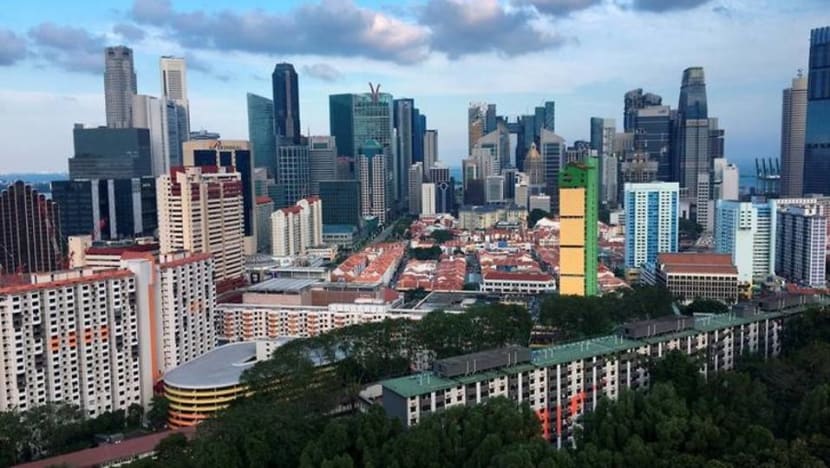Singapore maintains full-year GDP forecast as economy expands 3.9% in Q2
However, slower growth is expected in the second half of 2018 with increasing uncertainties and downside risks in the global economy.

A view of the skyline of Singapore. (File photo: Reuters/Woo Yiming)
SINGAPORE: Singapore will maintain its growth forecast for 2018 as data showed the country’s economy grew at a slightly better-than-expected 3.9 per cent in the second quarter from a year ago, the Ministry of Trade and Industry (MTI) said on Monday (Aug 13).
Gross domestic product (GDP) is anticipated to grow between 2.5 and 3.5 per cent this year – a range the Government had updated in May, from an initial forecast of 1.5 to 3.5 per cent.
For the second quarter, the year-on-year GDP figure is a slight upward revision from the Government’s initial estimate of 3.8 per cent, but a moderation from the 4.5 per cent in the previous three months.
On a quarter-on-quarter seasonally adjusted annualised basis, the Singapore economy expanded at a slower pace of 0.6 per cent, compared to the 2.2 per cent growth in the first quarter and coming in below MTI’s forecast of 1 per cent.
Both figures underperformed a Reuters poll of 10 economists who expected second-quarter GDP growth to be 4.1 per cent on a year-on-year basis and 1.3 per cent on a quarter-on-quarter basis.
Growth during the April to June period was primarily supported by manufacturing – which extended the double-digit growth from the previous quarter to grow by 10.2 per cent year-on-year – wholesale trade and business services, as well as the finance and insurance sectors.
SLOWER GROWTH AHEAD IN SECOND HALF OF 2018
Moving into the second half of the year, MTI said it expects the economy to see a moderation in its pace of expansion.
This comes amid expectations of a growth slowdown in several of Singapore’s key final demand markets, such as the US, Eurozone and China.
At the same time, uncertainties and downside risks in the global economy have increased, said MTI.
For one, recent tariff measures from the US have led to retaliatory moves from China, the European Union and several of its key trading partners. There is a risk of further escalation that could lead to a “vicious cycle of tit-for-tat measures” between the US and other major economies, said MTI.
“Should this happen, there could be a sharp fall in global business and consumer confidence, and in turn, investment and consumption spending. This could then have an adverse impact on global trade flows and global growth.”
READ: With the world "moving a little closer" to a trade war, what’s the impact on Singapore?
Meanwhile, against the backdrop of generally tightening global financial conditions, an upside surprise in inflation could lead to a faster-than-expected normalisation of US monetary policy, the ministry said.
This could trigger “disorderly capital outflows” from emerging markets in the region, causing financial vulnerabilities in these economies to surface, particularly for those with elevated debt levels.
Some pullback in investment and consumption growth, with spillover effects on the rest of the region, will happen as a result, MTI added.
Domestically, the Singapore economy will continue to be supported primarily by outward-oriented sectors, such as manufacturing, finance and insurance, wholesale trade as well as transportation and storage, which are expected to remain on an expansionary path.
The underperforming construction sector should see a bottoming out towards the end of the year despite recently announced property curbs, said MTI’s economics division director Yong Yik Wei.
This is largely due to support from public sector projects, which form between 60 per cent and 70 per cent of the construction projects coming on stream, Ms Yong explained during the ministry’s quarterly briefing.
Officials also said that the latest housing curbs are unlikely to dampen the broader economy, except for “some slight impact” on the real estate segment which accounts for just 4 per cent of total GDP.
Meanwhile, data from Enterprise Singapore showed Singapore’s non-oil domestic exports (NODX) climbed 9.4 per cent year-on-year in the second quarter, while trade expanded 10.2 per cent.
The Government’s 2018 growth forecast for NODX was adjusted to between 2.5 and 3.5 per cent, from 1 to 3 per cent. Full-year projection for total trade was also revised upwards to a range of 5 per cent to 6 per cent.
Editor's note: An earlier version of this story said that about 70 per cent of construction projects coming on stream are public sector projects. The correct figure is 60 to 70 per cent. We apologise for the error.















